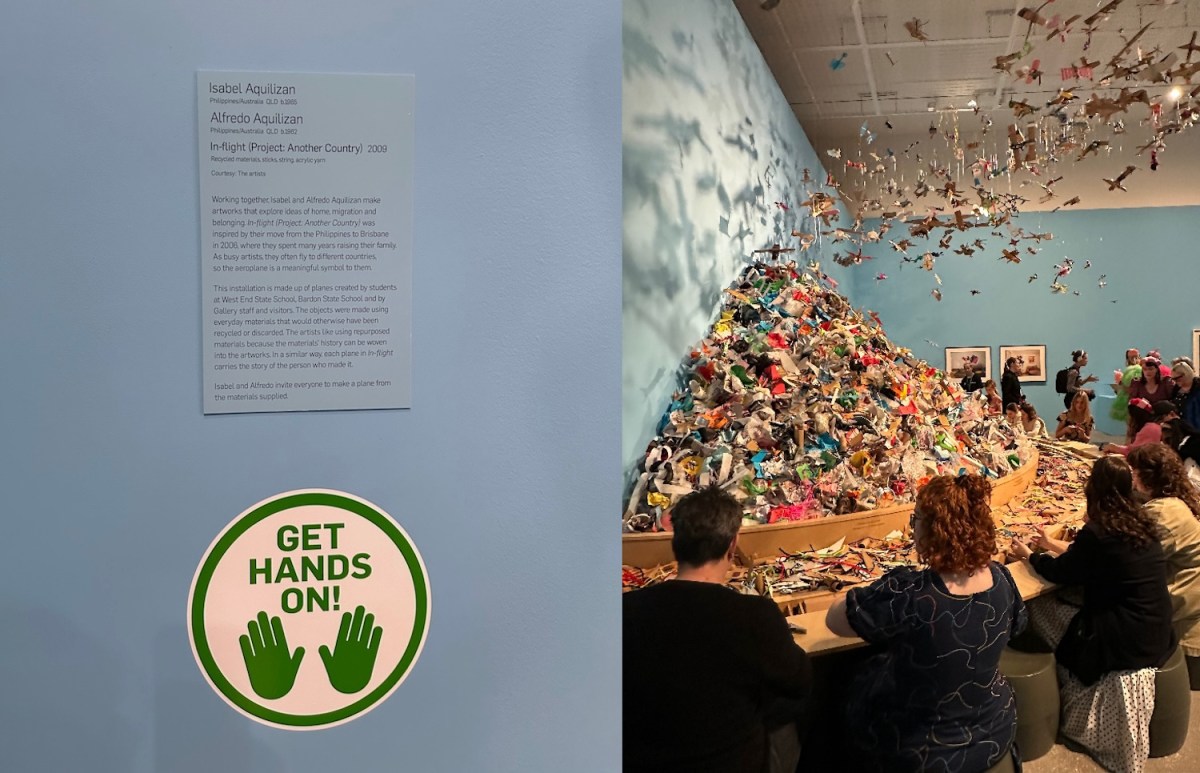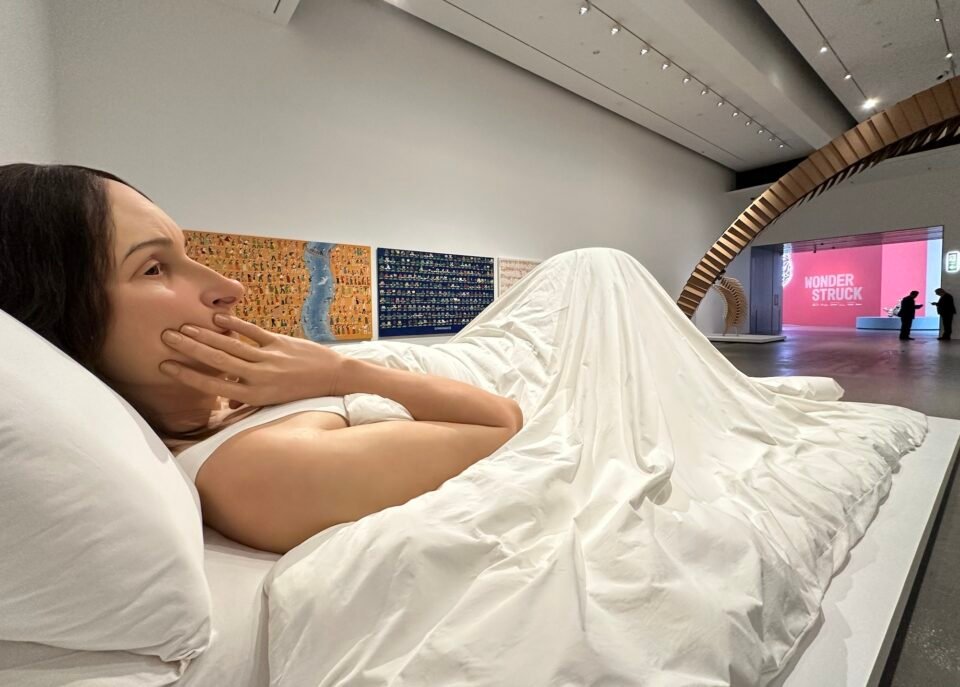Most exhibitions have subtle labels requesting viewers to not touch the art. Wonderstruck, rather, has bold signage inviting ‘Hands On’. The new exhibition at the Queensland Art Gallery I Gallery of Modern Art (QAGOMA) has been co-curated by Tamsin Cull, Head of Public Engagement and Laura Mudge, who heads up QAGOMAs Children’s Art Centre. The two have worked together for more than a decade to shape how visitors engage with the artworks, and it shows.
Over 100 works have been pulled out of the basement for this exhibition. QAGOMA has always been great at activating its collection holdings, often with thematic deep dives, such as the highly successful exhibitions The China Project (2009) and Unnerved: The New Zealand Project (2010). What I like about this organisational position is that the Gallery books these exhibitions on par with its other programming, and Wonderstruck is a great example.
Read: The problem behind sensational damage in galleries
QAGOMA has put lot of belief in this show: it opened this past weekend with a full festival of programs, new digital in-gallery assets and a decent marketing spend. But the biggest signal of a shift in-house is that Wonderstruck takes up prime gallery real estate. Indeed, this means the complete ground level galleries at GOMA – usually reserved for those high drawcard blockbusters, and the traditional domain of the curatorial department.
But does it inspire wonder?
This exhibition’s agenda is clear from the start. Down the central axis of GOMA is a hands-on drawing studio, which backs on to Yayoi Kusama’s much-loved, The Obliteration Room (2002-present), at the river end of the building.
However, the first gallery you enter is suffocatingly overstimulating. Maybe that’s a well-attuned response to the tastes of today’s young gallery audiences? Visitors walk in to Tobias Putrih’s cardboard arch, Connection (2004), which proposes a kind of proscenium arch to a piece of awe-inspiring theatre of works, with the main protagonist Ron Mueck’s hyperreal sculpture, In bed (2005).
I would argue Mueck’s piece demands its own space, and that a palpable connection is diluted in its congested display. Further, N S Harsha’s massive triptych, We come, we eat, we sleep (1999 – 2001) is pinned in behind it, with viewers overlooking its intimate surface engagement.
To the other side of Mueck, is a collection of works by Ai Wei Wei, Romuald Hazoumè and Stuart Ringholt that are in sync with the curatorial premise of wonder in the everyday, and yet their impact is similarly dwarfed. These works may be great at reading the contemporary zeitgeist, but their placement is not a great read of the space – the scale is all over the place, leaving one feeling discombobulated.
However, the exhibition does have its sweet moments and elegant pairings. Monir Shahroudy Farmanfarmaian’s expansive mirrored work, Lightning for Neda (2009) with Kohei Nawa’s much-loved PixCell-Double Deer#4 (2010) – a kind of morphed deer in a disco ball aesthetic – is bling-wonder personified and a highlight of the exhibition.

And within its sightline is the hands-on abstraction by Syagini Ratna Wulan, Monad (2021), which explores mandala aesthetics, leading into Jemima Wyman’s mandala of hand-cut digital photographs, Aggregate Icon (Kaleidoscopic Catchment) (2014), which in turn leads to her immersive video space Pattern Power Moves (version 2) (2014). These are smart and fun threads for visitors to follow.
This second gallery is curatorially tight, engaging and delivers on the show’s title. Similarly, a cluster of artworks by Gemma Smith, Bridget Riley and another by Ratna Wulan Parhelion (2021) is stunning – demonstrating that wonder can be delivered in many forms.
Stand-alone installations across the exhibition include a new presentation of Nick Cave’s Heard (2012), Sandra Selig’s wondrous installation mid-air (2003), using hundreds of metres of delicate white thread and small styrofoam balls, and Brian Robinson’s animated prints in a career-altering piece, Lagalgal: The Mysteries of our Land (2022). In some ways, the quiet space of Selig’s installations presents the most awe-inspiring pieces in this show.
The most obvious collection of works is in the final gallery space, which focuses on the idea of flight. Again it is over-hung, but is pulled off this time due to the tighter connection between works. Here viewers can sit down and participate in Isabel and Alfredo Aquilizan’s installation In flight (Project: Another Country) (2009), while overhead are works by Yvonne Koolmatrie, Louise Weaver, headdresses by Ken Thaiday Sr and a further menagerie of artworks.

Wonder for this writer take a different tone, less of the power-impact and more one of curiosity with other pairings, such as a collection of Hermansberg School watercolours next Michael Parekōwhai’s gravity-defying sculpture of a seal balancing a baby grand piano on its nose, The Horn of Africa (2006), and the small spirit house Kwaia koromb (2012), created by Papua New Guinea-based Kwoma Arts Collective with a trio of busts by Ah Xian – pushing and pulling at our thought processes. It creates a certain unease rather than an elevation, but nevertheless awakens us.
For many, these works are familiar (some collected since the 1990s), so they perhaps don’t offer the punch of that first awe-slap of ‘wow’. But this exhibition is about new audiences more than the converted – and from that perspective we know these pieces work. They are family friendly and Insta friendly.
Putting those critical curatorial lenses aside, the exhibition is a fantastic piece of programming for the school holidays and beyond as a learning tool for teachers.
QAGOMA has led Australia with its Children’s Arts Centre. Active since 1998, it has set an international example, especially in its early days. This exhibition celebrates that home-grown excellence.
Wonderstruck is definitely a worthy show and gives it a good go. The best part is that it is totally free, at a time globally when we are feeling the pinch and hankering for a bit of joy in our lives.
Wonderstruck
Queensland Art Gallery I Gallery of Modern Art (QAGOMA)
28 June – 6 October 2025
Curators: Tamsin Cull and Laura Mudge
Free
Artists: Ah Xian, Nick Cave, Monir Shahroudy Farmanfarmaian, Gordon Hookey, Madeleine Kelly, Yvonne Koolmatrie, Craig Koomeeta, Yayoi Kusama, Rosemary Laing, Ron Mueck, Patricia Piccinini, Brian Robinson, Sandra Selig, Gemma Smith, Yuken Teruya, Judy Watson, Louise Weaver, Jemima Wyman and more
The writer travelled to Brisbane as a guest of QAGOMA and W Hotel.

